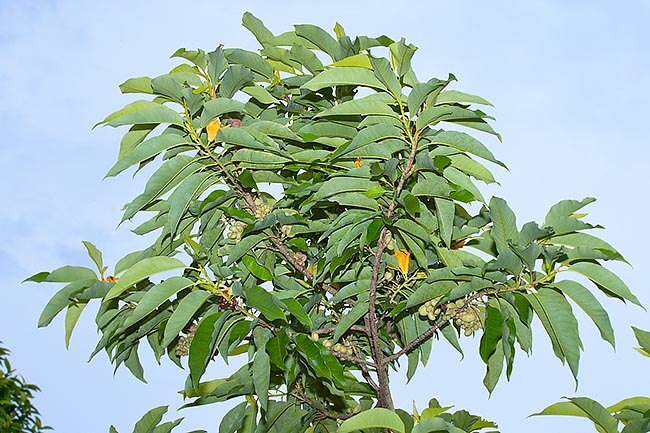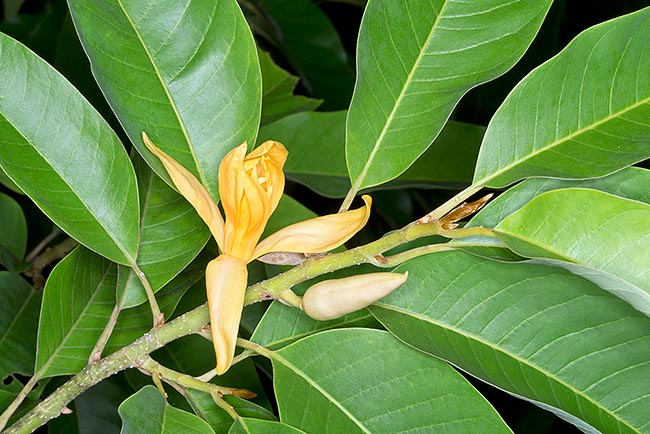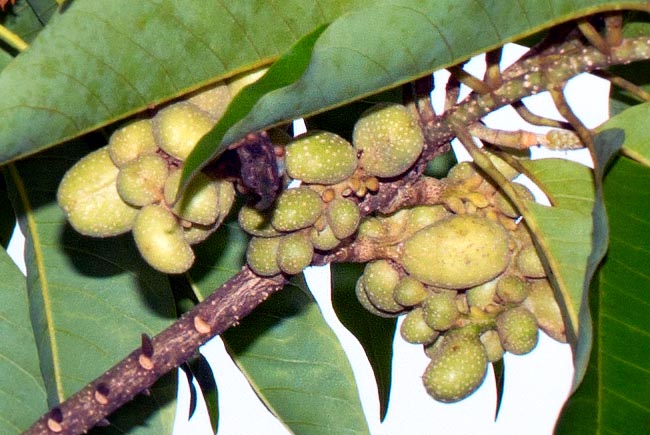Family : Magnoliaceae

Text © Pietro Puccio

English translation by Mario Beltramini

At home in South-East Asia, Magnolia champaca may reach the height of 30 m © Giuseppe Mazza
The genus is honoured to the French physician and botanist Pierre Magnol (1638-1715), director of the Royal Botanic Garden of Montpellier; the specific name is the local Indian name,“champaka”, in Sanskrit.
Common names: champa, fragrant champaca, golden champa, joy perfume tree, yellow jade orchid tree (English); tita-sopa (Assamese), champa (Bengali); dam bac (Khmer); chen p’o, chen p’o ka, huang lan (Chinese); champa (Hindi); bunga cempa, tjempaka kuning (Indonesian); solo (Lao); champaka, chempa putch (Malay); champ (Nepalese); sambagan (Tamil); cham phaa (Thai); champangi (Telugu); tsam ba ka, tsam pa ka (Tibetan); ngoc ian, su nam (Vietnamese).
The Magnolia champaca (L.) Baill. ex Pierre (1880) is an evergreen, or semi-deciduous in the cooler climates, tree, 9-30 m tall, with dense foliage and cylindrical erect trunk, of 50-80 cm of diameter, with grey-brown smooth bark; the young branches and the buds are covered by yellowish tomentum. The leaves, on a 2-4 cm long petiole, are simple, alternate, ovate-elliptic with long pointed apex and entire margin, 10-25 cm long and 4-10 cm broad, of intense glossy green colour above, slightly pubescent below, coriaceous. Deciduous stipules (leafy appendages at the base of the leaf having the main aim to protect it during the initial growth phase) covered by a thick rust coloured tomentum.

The pale yellow or orange flowers reach the 6 cm of diameter. Much perfumed, have an important rôle in the Buddhist and Hindu traditions. Essential oils for cosmetics industry and medicinal virtues © Giuseppe Mazza
Conical 5-15 cm long infructescence with obovoid fruits (follicles), 1-1,5 cm long, of brown colour, warty, containing 1-4 angular seeds, covered by fleshy pink aril, oily, having a short lasting germinability.
It reproduces by seed, previously cleaned from the aril, that contains a powerful inhibitor, scarified and immersed in warm water for one day, in organic draining soil for acidophiles maintained humid at the temperature of 26-28 °C, with germination times varying from 2 weeks to 3 months, and first blooming starting at the age of 6-7 years. The varieties are propagated by grafting.
Species of great ornamental value and of potential economic importance that since remote times has had an important role in the life and in the civil and religious ceremonies of the local populations. The tree is widely present in the parks and in the gardens, especially in India, and is not absent close to the temples; its flowers, produced almost continuously, are used as ornament and for perfuming the ambients, but especially have an important place in the Hindu and Buddhist traditions.

Conical, 5-15 cm long infructescence with fruits (follicles) 1-1,5 cm long, warty, containing 1-4 angular seeds, covered by fleshy pink aril, having a low germinability duration. The varieties are propagated by grafting © Giuseppe Mazza
Cultivable in the tropical and humid subtropical regions and marginally in the temperate warm ones, where temperatures less than 5 °C are exceptional events and of very short duration; requires an exposition in full sun or a partial shade and draining soils, preferably sandy, fertile, deep, humid, but without stagnations, acidic or neutral.
The essential oils extracted from the flowers are utilized in the cosmetics and perfume industry and stand among the most expensive perfumes ingredients, of which the most known is the “Joy”; from them they extraxt also a dye.
The wood, of good quality, is utilized in carpentry, for furnitures, panels, fixtures and in the plywood industry.
All parts of the plant are variously utilized in the traditional medicine for numerous pathologies.
Synonyms: Michelia champaca L. (1753); Michelia euonymoides Burm.f. (1768); Champaca michelia Noronha (1790); Michelia sericea Pers. (1806); Michelia suaveolens Pers. (1806); Michelia rufinervis DC. (1817); Michelia aurantiaca Wall. (1831); Michelia rheedei Wight (1840); Michelia blumei Steud. (1841); Michelia champaca var. blumei Moritzi (1846); Sampacca euonymoides (Burm.f.) Kuntze (1891); Sampacca suaveolens (Pers.) Kuntze (1891); Magnolia membranacea P.Parm. (1896).
→ To appreciate the biodiversity within MAGNOLIACEAE family please click here.
